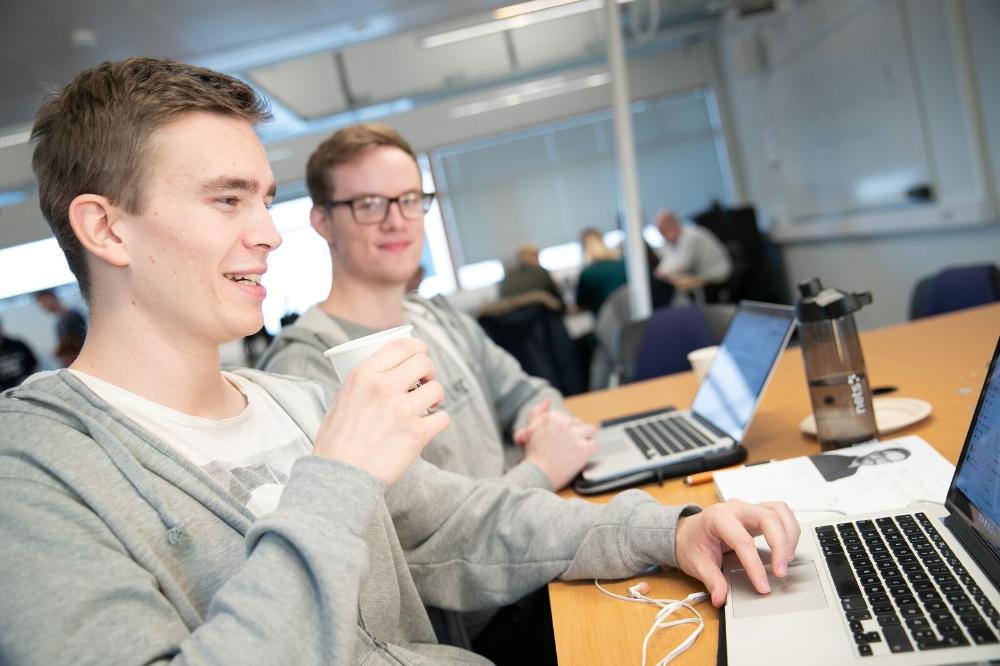Drag and drop programming tasks for digital exams
Drag and drop programming tasks for digital exams

- The programming exams have always been by handwritten tests, which has been quite hopeless. Both the writing process and the grading process have been cumbersome, and with a lot of manual work, Simon Kvannli explains.
Together with Joachim Jørgensen, he is working on a master's thesis in Informatics in collaboration with Excited, which aims to streamline the use of the digital Exam platform Inspera for programming tasks.
There is already a drag and drop feature in Inspera that makes it possible to create programming tasks. The students, based on a description of what the code should represent, are given snippets of code, and the task is to place the correct code snippets in the correct order. Points are awarded for each code snippet that is placed correctly, which in turn automatically generates a grade rating. The problem is that creating these assignments takes a very long time for the teacher. The program the master's students are working on with will ideally create large amounts of almost identical assignments, almost eliminating the need to manually create assignments.
- Generating one task does not necessarily have to be so much more efficient with our program than if it were done manually. The difference is that we can make the program generate, for example, 10,000 tasks that are almost the same, but not completely. This also reduces the risk of cheating, since all students have been given different tasks, Kvannli explains.
Fairer assessment
Centre manager for Excited, Guttorm Sindre, is the supervisor for the master thesis and believes the project can make a big difference for the course teachers.
- Some of the courses we offer have very high student numbers, we are talking 500 + students. Some courses have several thousand students from several study programs. The challenge then, among other things, will be that it is very time-consuming to grade the exam, even with hired examiners.
He also points out that it can provide fairer grading.
- The sensors are only human, and then there will always be a human assessment that is the basis. If you get the opportunity for automatic correction, the results will be much fairer, says Sindre.
And that is not the only way the project can contribute to a fairer assessment of students.
- It has been a recurring theme that the students want to have the final course grade also be partly set by assessments during the semester, so that not everything stands and falls on the one final exam. Until now, we have not been able to offer this, as grading the assignments will simply be too much work. With automatic correction, this can also be an option.
This is a motivating factor for Kvannli and Jørgensen.
- You are much more vulnerable if your grade depends fully on your performance four hours at the end of the year. And with ongoing assessment, you also get an incentive to work evenly throughout the semester, says Jørgensen.
- It is also very motivating for working on our thesis, that the project can make an actual difference. That it can contribute to changing the structure of more of the courses, Kvannli adds.
Finished before Christmas
Right now, the two master's students are working on automatically generating snippets of code that are among the alternatives, but which should not be included in the answer. Although the assignment will not be delivered until the summer, they hope to have a product ready for testing before Christmas.
- We must test both the professors and the students' user interface. With the professors, there will be classic A / B testing, to see how much time they could save, Jørgensen explains.
That is, they let one group generate tasks with their program, while another group does it manually.
- Then we must test that it works for the students. That the tasks have a good quality, he adds.
In addition to streamlining the programming tasks in Inspera, Professor Sindre also envisages that the program can be further developed in the long term and used for other types of tasks as well. The students themselves are not thinking about that right now.
- It is open to expansion, and to use the program to solve other types of problems, but for this master's thesis we need to limit our scope, Kvannli says.
Insipra integration
He explains that the thesis proves more that this is possible to implement in the system and works in practice, and that any further development may take place afterwards. At the same time, they want to engage Inspera in developing this for all universities.
- If this ends up in production, then it is definitely something I can imagine working on, but we will see if it comes to that. Optimally, it should have been part of Inspera.
- It may be that they become interested. And that will not be a problem for us. We can send them our code, no problem! says Jørgensen.
Excited focus our efforts on these core projects:
Informed Decision
Increasing the knowledge of IT and the IT profession for pre-university students
Projects of Becoming
Supporting new students to embark on two challenging projects: in the short term to become a student, in the longer term to become an IT professional.
Learning through Construction
Aims to maintain and further develop students’ interest and excitement by creative design of IT artefacts
Sharing and Diversity
Developing highly efficient cross-campus learning spaces and spaces for teacher sharing of experiences and learning resources
Career Readiness
Aims to strengthen and expand the education-work connectivity by providing students’ with “real-life industry-driven” learning
